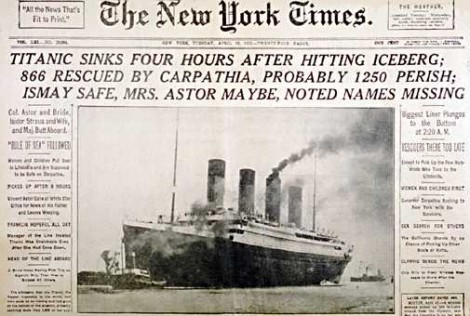
If this is true, it has to be the most famous, most catastrophic UI design blunder ever:
“The error on the ship’s maiden voyage between Southampton and New York in 1912 happened because at the time seagoing was undergoing enormous upheaval because of the conversion from sail to steam ships. The change meant there was two different steering systems and different commands attached to them. Some of the crew on the Titanic were used to the archaic Tiller Orders associated with sailing ships and some to the more modern Rudder Orders. Crucially, the two steering systems were the complete opposite of one another. So a command to turn “hard a starboard” meant turn the wheel right under the Tiller system and left under the Rudder. When First Officer William Murdoch spotted the iceberg two miles away, his “hard a-starboard” order was misinterpreted by the Quartermaster Robert Hitchins. He turned the ship right instead of left and, even though he was almost immediately told to correct it, it was too late and the side of the starboard bow was ripped out by the iceberg. “The steersman panicked and the real reason why Titanic hit the iceberg, which has never come to light before, is because he turned the wheel the wrong way,” said Lady Patten…”
– from Titanic sunk by steering blunder, new book claims By Richard Alleyne (21-Sept-2010)
It makes you wonder wonder what the hell was running through the engineers’ minds when they decided to have two steering systems with inverted controls, so on one system left meant left, and on the other left meant right. Maybe they shaved a few thousand dollars off the total build cost. Crazy.
Update 1: I stand corrected (Thanks Tony!) – what this amounts to is a catastrophic migration issue – the Quartermaster was used to sail ships where their orders and mechanics of steering worked one way. On the Titanic, the orders and mechanics were allegedly different, hence the confusion. You can read more about this in “That Damned Ship’s Wheel!” by Dave Gittins, quoted below:
“Until relatively recent times, naval seaman in particular had to steer vessels by at least five steering systems, not counting the obsolete whipstaff. Large ships had wheels. Small power and sailing boats had tillers and some boats, such as whale boats and some lifeboats, had steering oars. Rowing boats were often steered by a steering yoke controlled by short lengths of rope. In an emergency, large ships were sometimes steered by tackles attached to the tiller below decks. At a pinch, Titanic could be steered by connecting her warping capstans to the tiller. It simplified things if the officer in charge gave all orders with reference to a real or hypothetical tiller. It was part of a seaman’s skills to react correctly to the order.”
Update 2: OK, I’ve now had feedback from a few people saying that this story is not about the steering controls but about the orders from the officers in charge. Prior to the 1930s, officers used tiller orders (if you want to go one way, you push the tiller the other way) After the 1930s, they switched to rudder orders (you steer in the direction you want to go). The theory is that there was some confusion due to the switch over from one style of controls to another. However, since the Titanic sank in 1912, they are highly unlikely to have been in the middle of a rudder/tiller order switch over.
Hi Harry,
I think the difference is that the two systems weren’t simultaneously used on the same vessel – (or at least I sencerely hope not) – my interpretation is that this is a migration from one system to another across the whole industry. A bit like changing from driving on the left to driving on the right (which I’m sure some nations have done). Might make sense for all sorts of reasons, but not without its risks. I doubt it was the engineers who were making these decisions too.
Cheers,
Tony